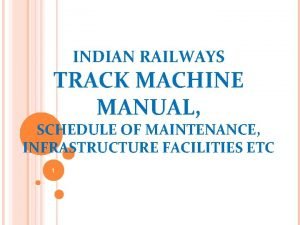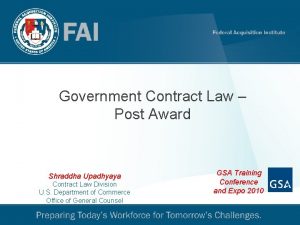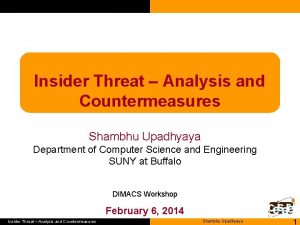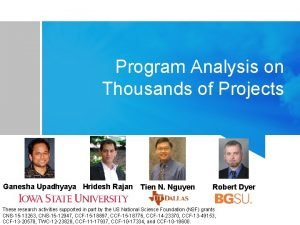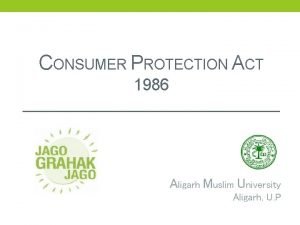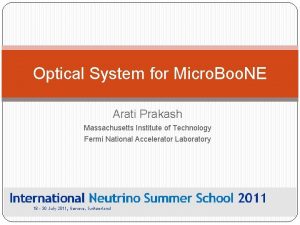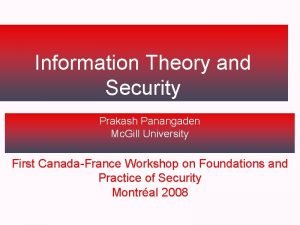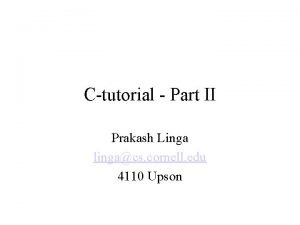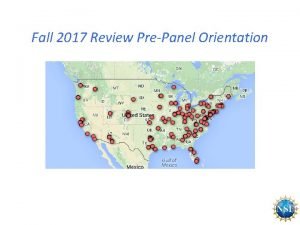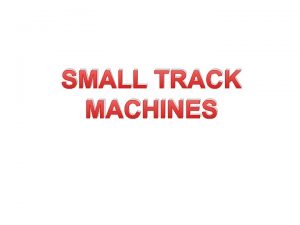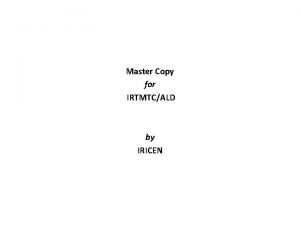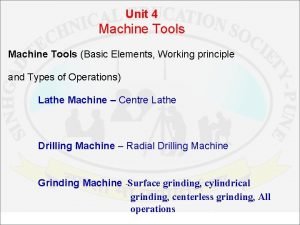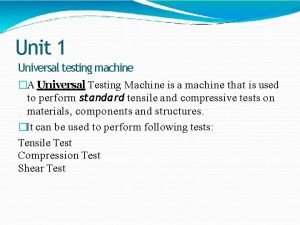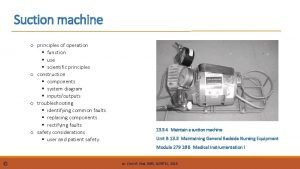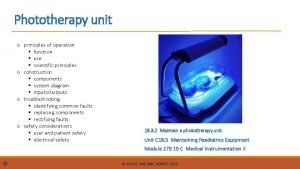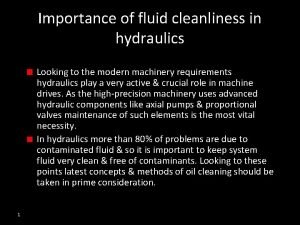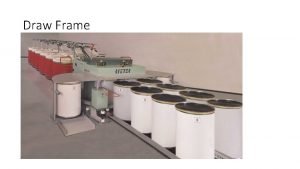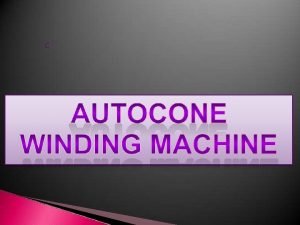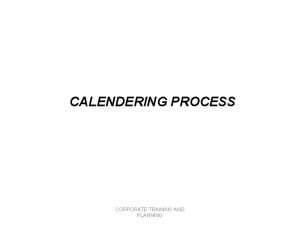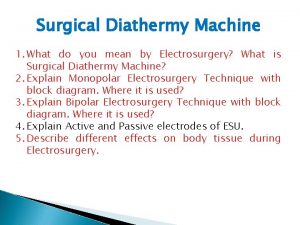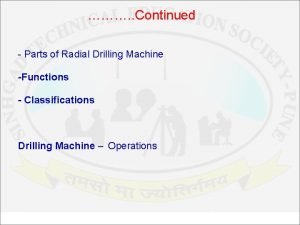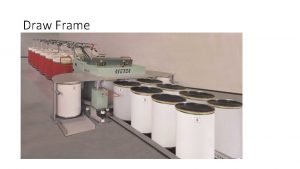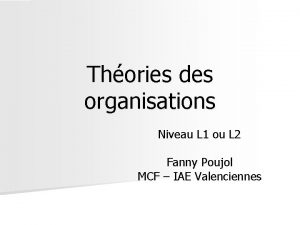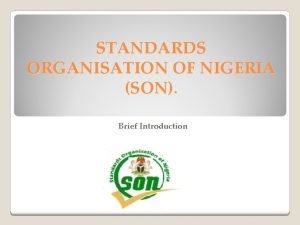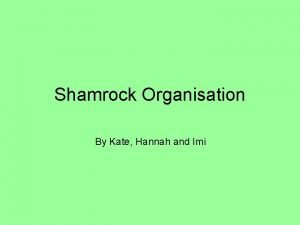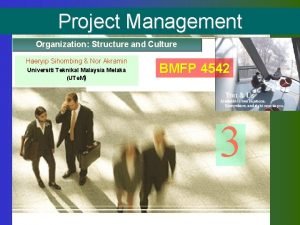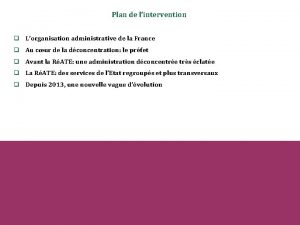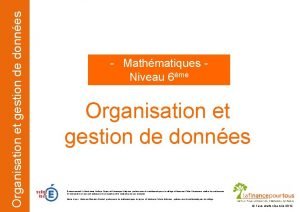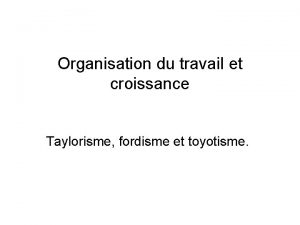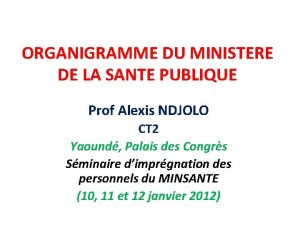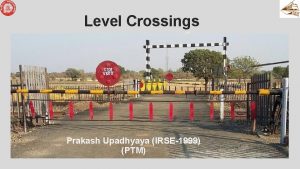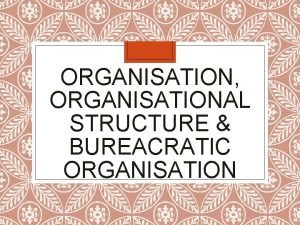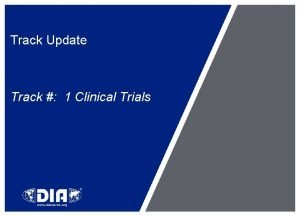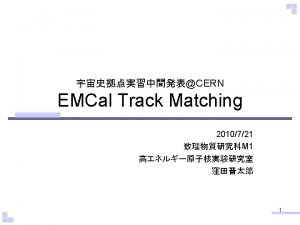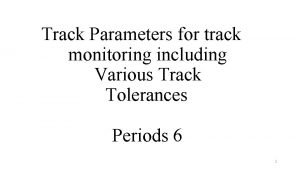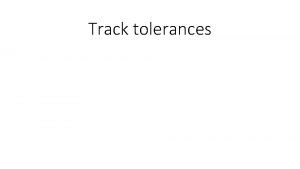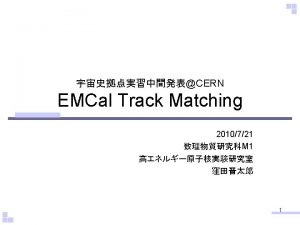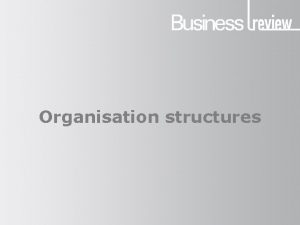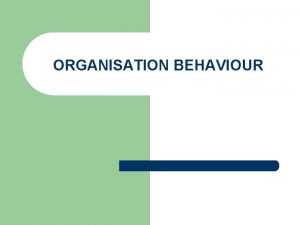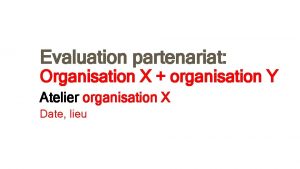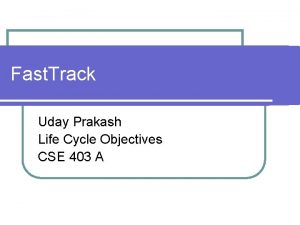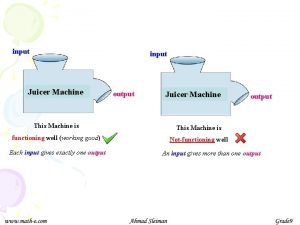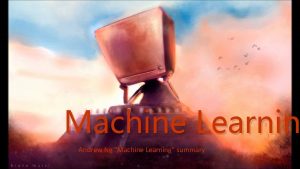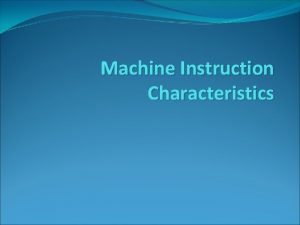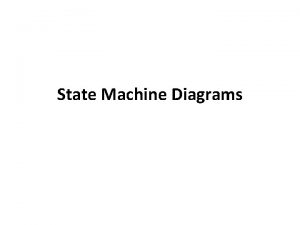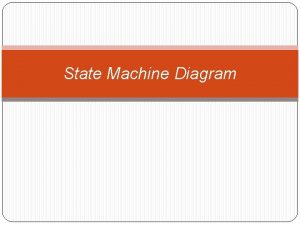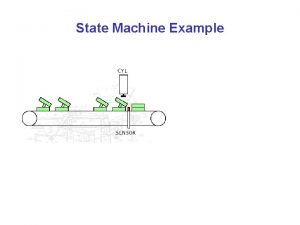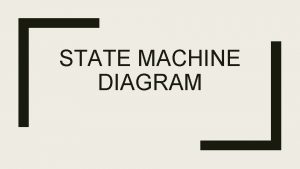TRACK MACHINE ORGANISATION ITS WORKING PRAKASH UPADHYAYA IRSE1999





















































- Slides: 53

TRACK MACHINE (ORGANISATION & IT’S WORKING) PRAKASH UPADHYAYA (IRSE-1999) PTM

MANUAL IRTMM-2019

Track Machine Organization – Role • Track Machine Organization on Zonal Railway will be the custodian of on-track machines. • TM Organization is responsible for – preparing Machine Deployment programme and making the machines available accordingly. – for manpower planning of track machine organization. – Procurement of spares and consumables for maintenance of track machines • Track Machine Organization will monitor the output of machines for quality and performance with respect to blocks given.

Track Machine Organization – Role • Each zone shall have at least one zonal maintenance depot and each division shall have at least one satellite depot for overhauling, repair & maintenance of machines. • The track machines shall work as per divisionalised system of working with division managing all day to day affairs including minor repairs, arrangement of consumables, staff matters and ensuring suitable working conditions for track machine staff. • There may be some variations among the zonal railways.

Functions of Track Machine Organization shall be under the overall charge of Chief Engineer/Track Machines (CE/TM) of the Zonal Railway. Organization is responsible for: • Manpower planning including their training and development. • Planning and deployment of track machines. • Operation and monitoring of track machines. • Repair and maintenance of track machines.

ORGANISATIONAL STRUCTURE CE /TMC DY. CE /TMC/HQ XEN /TMC/HQ AXEN /TMC/HQ SSE/JE /TMC/HQ DY. CE /TMC/LINE XEN /AXEN (TMD) (Zonal Maint. Depot) SSE/JE/TMD XEN /AXEN (L) (Inspection & Satellite Depot) SSE/JE/TMC (Machine Operator) TMM DY. CE /CPOH XEN /AXEN SSE/JE TMM

DUTIES OF DIFFERENT DY/CE/TM UNITS • Deputy Chief Engineer/TMC/HQ and his team in Headquarter shall be responsible for : • deployment planning of machines, • finalization of Annual Maintenance Contracts, • planned procurement of spares and consumables for CPOH & Line both, • co-ordination with division etc. • Deputy Chief Engineer/CPOH and his team shall be in charge of CPOH workshop and will be responsible for periodic overhauling of Machines & tamping units of nominated zones.

DUTIES OF DIFFERENT DY/CE/TM UNITS • Deputy Chief Engineer/TMC/Line and his team, posted in Zonal Maintenance Depot, shall be responsible for: • operation and maintenance of machines including emergency repairs and procurement. • proper deployment of Track machine staff, • initiation of proposal for AMC as well as that of procurement of spares and consumables in planned manner. • The maintenance workshops in Zone i. e. Zonal Maintenance Depots (ZMD) and Satellite Depots (SD) in the divisions shall also be under his control. IOH and major repair activity shall be done in these depots.

DUTIES OF DIFFERENT OFFICIALS • Each machine is manned by SSE’S/JE’S/TM including one Incharge (I) , MCM &TMMs (Technician) and Machine Assistants (Helper) • Each machine shall be worked under the direct charge of SSE/JE/TM during the movement and working of track machine. He shall be in possession of the valid competency certificates, road learning and medical fitness certificate for working the machine. • SSE/JE/TM/I shall have additional responsibility of Maintaining records of repair/Block/Spares and coordinating with Division and Satellite depot in-charge etc.

DUTY ROASTER Track Machine staff falls under continuous classification as per HOER. Normally , Roaster should be weekly, however following two types of Roasters are followed: • Weekly Roster. The staff is rostered to work for a period of 6 days at a stretch followed by one day of rest. • Three Weeks Roster. Staff working on Track Machines may be rostered to work for a period of 3 weeks at a stretch followed by continuous rest for a period of one week at headquarters In addition daily Duty Hours for Field are decided by Sr DEN.

INSPECTION SCHEDULE OF TRACK MACHINE OFFICIALS Track machine* RGM TRT TLE/ PCCM TEX/CSM/ UNIMAT WST BCM/ SBCM MPT/DTS/BRM/ UTV/RBMV Inspection frequency of Track Machine Officials Dy. CE/TM/ Line AXEN/ TM/Line SSE/TM/SDI or SD 3 months Monthly Fortnightly (Owning Railway) Monthly (Owning Railway) Fortnightly (Owning Railway) Weekly (Working Railway) 6 Months 1 Year (Working Railway) Monthly 2 Months 3 Months 2 Months (Working Railway) Fortnightly Monthly 4 Months 2 Months Need Basis

INSPECTION SCHEDULE OF OPEN LINE OFFICIALS Track machine* Inspection frequency of Track Machine Officials Sr. DEN ADEN SSE/PWAY/Inch. /Sec. TEX, CSM, DTS, WST, 3 Months UNIMAT and SBCM Fortnightly RGM, TRT, TLE, PCCM and 2 Months BCM MPT, BRM, UTV, RBMV etc. Need Basis Fortnightly During supervision of pre-block, during block and post-block works but not less than once a week 3 Months Sr. DEN/DEN and ADEN shall inspect the track machines as per above schedule, duly covering other aspects like, adequacy of allied track works, quality of machine work, safety aspects involved, items pertaining to the welfare of machine staff, records such as programme of tamping, actual tamping, variations, repeated tamping, speed restriction etc

MAINTENANCE SETUP Five types of repairs and maintenance facilities/ workshops are to be developed as below: • Central Periodical Overhauling Workshop (CPOH) • Intermediate Overhauling Workshop (IOH)/Zonal Machine Depot • Satellite depot • Mobile Workshop cum Transport Van • Camp Coach Workshop

MAINTENANCE SCHEDULE- I to V Group of Machines All machines except RGM Type of Schedule -I Schedule –II Schedule -III Schedule IV Schedule -V Periodicity Daily 50 Hrs. 100 Hrs. 200 Hrs 1000 Hrs Location TM Siding SD/ZMD Duration One Hour Two hours 01 day 02 Days 07 days Periodicity Daily 50 Hrs. 250 Hrs. 1000 Hrs 3000 Hrs Location TM Siding CPOH Duration 08 Hour 10 hours 12 hrs. 03 Days 10 days

MAINTENANCE SCHEDULE- VI & VII MACHINE OTHER THAN RGM Schedule Type Periodicit y (Engine hours) FOR RGM Machine Group – I (TLE, Machine Group – II (WSTBRM, RBMV & UTV) 08 -32, UNIMAT-2 S &3 S& (PCCM, DTS & TRT) HOT-CSM) Machine Group – III Schedu Periodicit (HOT-3 X & UNIMAT-4 S) le Type y (Engine (BCM, SBCM) hours EH) Duration Location Duration Schedule – VI 2000 (IOH) PCCM, DTS: ZMD (IOH) 21 Days, TRT: 45 days and other 15 days. 30 days ZMD For ZMD BCM/SBCM 45 days. For others 30 days Schedul 6000 e – VI (IOH) 20 days CPOH Schedule – VII (POH) 1 st – 60 days, 2 nd – 75 days CPOH For BCM/SBCM 1 st – 90 days, 2 nd – 105 days. For Other 1 st – 75 days, 2 nd – 90 days Schedu 15000 or le – VII 60 months (POH) which everislater 1 st POH 45 Days 2 nd POH-60 Days CPOH 1 st – 8000, 2 nd – 14000 and then at 4000 Location For TRT ZMD/ st 1 – 70 days, CPOH 2 nd – 90 days. For Other 1 st – 45 days, 2 nd – 60 days Location Machine Group IV (RGM) CPOH Duration Location

CPOH WORKSHOP Existing ØAllahabad-NCR (Caters for NR, NCR, NER, NWR, NFR, ER, ECR, SER, WCR, WR) ØRaynapadu-SCR (Caters for SR, SCR, SWR, ECo. R , CR, SECR, SCo. R) Sanctioned and under construction ØKanchrapara-ER ØVatva near Ahmedabad-WR

FUNCTION OF CPOH WORKSHOP • POH of machines • Overhauling of Øtamping units, Øtransmission gearboxes, Øaxle assembly and Ølifting, lining assembly for unit exchange either at shop floor or field.

CPOH PLANNING • POH Programme from Zonal Railways • Finalization of POH Programme by CPOH Workshop • On that basis Railway Board issues POH Planning The planning includes POH of Machines and Overhauling of Tamping bank and distribution of overhauled tamping Bank for 2 years period • During POH a joint report between CPOH and Railways supervisor is made for works proposed to be performed. • RDSO has issued Guidelines for work to be executed during POH • Performance Monitoring by CPOH is done after M/c is dispatched to Railways.

Zonal Maintenance Depot (for IOH) • • At least One ZMD in each Zone This depot is used for IOH of machine as per schedule VI It also serves as workshop for major repair work of machines. Store of stacking spares. The expertise at ZMD are used to repair machines at site. Failure analysis etc is done here Machine monitoring is regularly done from here.

SATELITE DEPOT • • • To be provided one at least in Each division. Used for day to day monitoring of machines Regular requirement of spares are stocked here Repair which cannot be performed in field are done here Required plant and machineries are provided here Unit exchange are normally performed here.

CAMP COACH • It is for providing accommodation to Track Machine staff, storing of spares and has tools and plants required for regular and emergency maintenance of machines. • These are currently Non AC Coaches. However Railway may convert selective cabin/cabins into Air Conditioned cabin/cabins as per requirement. In this respect, electrical circuit may be modified accordingly

REST ROOMS FOR TRACK MACHINE STAFF

INDUCTION OF NEW MACHINES A. As per Railway Board Gazette Notification dated 1. 10. 2018: • RDSO shall apply for introduction of any new types of rolling stock different from those already running on any section or division of Railway administration to the central govt through Commissioner. • The application to commissioner will include – Full particulars of axle loads, infringements to SOD etc. – Provisional or final speed certificate etc. • The application shall be scrutinised and submitted to Central Govt (Rly Bd) with recommendations. • Commissioner may ask for oscillation trials for permitting new design of locomotives.

INDUCTION OF NEW MACHINES • In case of difference in opinion between RDSO and CRS of whether the vehicle to be taken as new, the decision of Central Govt will be final. • GM of Railway may sanction the use of any rolling stock already introduced on Indian Railway by central govt on any section or division of Railway under his control. • For this GM will be approached with following information's – – Provisional or Final speed certificate. Infringement etc Sanction of Central Govt JSC signed by Chief Engineer, Chief Mechanical Engineer, Chief Electrical Engineer (If electric stock) etc and include Track Certificate, Bridge certificate & OHE certificate(Proforma given in Rly Boards’s Policy Circular No-6) – GM shall communicate the sanction to commissioner 10 days in advance of its implementation

INDUCTION OF NEW MACHINES B. Speed Certification of New Machines (Railway Board Policy Circular No-6): Issued by ED (Motive Power)/RDSO Provisional speed: • On the basis of design features of machines, provisional speed certificate normally lower than maxm permissible speed but not more than 65 Kmph is issued. • It can be increased to 75 Kmph or further to speed permitted for similar vehicle following laid down procedures. • Valid for 5 years max or till superseded by Final Speed certificate

INDUCTION OF NEW MACHINES Final Speed Certificate: • This is normally issued after conducting detail oscillation trial. • For rolling stock which is not new , detailed oscillation trials may be dispensed with by RDSO following laid down procedure (consultation with related dte). • Separate speed certificate for conducting oscillation trial will be issued. Trial to be done at speed 10% in excess of proposed maxm speed except on curves. • Test stretch (Bad running section) is identified for this trial on the basis of last TRC run. • GM shall sanction such trial (Validity 2 years & may be extended further on advice of RDSO) in the section so identified after CRS sanction and on the basis of JSC signed by PHOD’s.

INDUCTION OF NEW MACHINES One time movement of new vehicle (From dock, for testing etc) • Speed certificate to be issued by RDSO and shall not be more than provisional speed. • PCE and PCME shall approve this movement on the basis of RDSO speed certificate and a JSC shall be issued for track bridge and OHE. • If there is any SOD or axle load is more than permitted, GM’s approval will be required. • Para-710 of IRTMM deals the system of Induction of new machines and speed certification in detail.

CODAL LIFE OF MACHINES AND POH/IOH FREQUENCIES Machines Rail Grinding machines (RGM) Codal Life 15 years POH Schedule Every 15000 ERH or 60 months whichever is Later All tamping machines i. e. Duomatic, CSM, Tamping Express, MPT, UNIMAT etc. 20 years 1 st POH: 8000 ERH. 2 nd POH: 14000 ERH And subsequent at every 4000 ERH or on condition basis. Ballast screening machines BCM, SBCM, Ballast Regulating machines etc 20 years 1 st POH: 8000 ERH. 2 nd POH: 14000 ERH And subsequent at every 4000 ERH or on condition basis. Track renewal machines like TLE, TRT, Points and Crossing changing machines, Dynamic Track stabilizer. Material handling machines UTV, RBMV 20 years 1 st POH: 8000 ERH. 2 nd POH: 14000 ERH And subsequent at every 4000 ERH or on condition basis. 25 years 1 st POH: 8000 ERH. 2 nd POH: 14000 ERH And subsequent at every 4000 ERH or on condition basis.

CONDEMNING PROCEDURE • A Committee of three SAG officers of the Zonal Railway, one each from Engineering, Finance and Electrical Engineering will examine the report, and finalize their recommendations. • The recommendations of the SAG Officers Committee will be forwarded to Board, duly accepted by PCE/CE (Coordination) • After approval of Railway Board, the railways will be advised for condemning the machine and write back the capital cost of the machine.

RULES FOR MOVEMENT AND BLOCK WORKING OF Track Machines ( IRTMM Ch-7 and Para-4. 65 of GR)

Categorization of Track Machines • For the purpose of movement and working, track machines are classified in two categories • Track Machines Hauled by Locomotive - TLE, TRT, PCCM, MDU Rules for movement for material trains will apply to these categories of machines. Other track machines when attached with the train/locomotive will also fall in the same category. • Self-propelled Track Machines – CSM, BCM, SBCM, UNIMAT etc.

Categorization of Track Machines • Self-propelled Track Machines – – For movement, these shall be worked as a train but will not need a guard or a brake van. – One camping coach or one BRN wagon or another selfpropelled track machine, which may be un-braked, shall permitted to be hauled by the self-propelled track machine. – SSE/JE/TM operating the machine shall ensure safe running.

Provision of G&SR • Provisions as contained in GR 4. 65 supplemented by SR framed by the Zonal Railways, shall be applicable for working of track machines. • Presently, SRs of Zonal Railways are not uniform. Objective should be to have common or unified SR for all Zonal Railways for common aspects of track machines working. • Specific provisions in respective SRs shall deal with special circumstances prevailing in individual Zonal Railways.

Knowledge of G&SR • Track machine staff shall be conversant with the relevant provisions of G&SR. • Adequate knowledge of provisions of G&SR shall be imparted during the initial and refresher training courses conducted in ZRTIs. • The list of standard forms is given in Annexure 7. 1 of IRTMM.

Competencies of Track Machine Staff • Medical Fitness and PME - SSE/JE/TM shall be fit in A-3 medical category • Technical Training - All SSE/JE/TMs are to undergo initial as well as refresher technical training imparted by IRTMTC, Allahabad; successfully. Refresher technical training shall be done every 3 years. • G & SR Training - All SSE/JE/TMs are to undergo initial as well as refresher training in G&SR; successfully. Refresher G & SR training shall be done every 3 years.

Competencies of Track Machine Staff • Route/Road Learning • It will be the responsibility of the SSE/JE/TM working the machine to acquaint himself with the system of working, location of signals and other local conditions affecting running of trains on a section(s) of the railway over which he is to work. • SSE/JE/TM will make trips in the cab of locomotive of a train for initial road learning for acquainting with the section as well as subsequent, if required, for reacquainting with the section as stipulated in G&SR of the railway.

Competencies of Track Machine Staff • Competency Certificate – – SSE/JE/TM shall be considered competent to operate the machine only if he possesses valid machine competency certificate. – Machine competency certificate is to be issued to SSE/JE/TM by Dy. CE/TM Line after ascertaining the successful completion of technical training, G & SR training and his medical fitness.

Competencies of Track Machine Staff • Competency Certificate – • The validity of this certificate will be up to the earliest expiry date of the three i. e. (i) Technical training (ii) G & SR training and (iii) PME. • For automatic block section, separate competency is required to be issued as per the practice in the Zonal Railway.

RULES FOR MOVEMENT AND BLOCK WORKING • GR provision 4. 65 deals with Track Machines and reads as : Track Laying or on track tamping or maintenance machines shall be worked only with the permission of the station master and in accordance with special instructions. • Special instructions is added by Zonal Railways: • Some add it in Operating Manual (Like Eco railway). • CR and SCR added in G & SR (Includes Competency, single line/multiple line working, Safety provisions , Tools etc.

IMPORTANT RULES OF M/c Working • Total number of the machines shall be clearly mentioned in the line clear/block authority message with exchange of private numbers. For this purpose two coupled self-propelled track machines are to be treated as single machine. • In case of group machines, entering into the block section for working, and back and entering the station after working, the first machine shall pass the dispatch/reception/last stop signal, as the case may be, in OFF position (where signal is given) and all other machines shall be piloted by competent Railway servant following first machine with signal in ON position.

IMPORTANT RULES & PRECAUTIONS • Run Through Movement in Group is not allowed. If required the movement should be done after taking short duration Traffic Block. • Track machine with one BFR, like UTV, shall also be treated as a single machine. • SSE/JE/P. Way shall perform the limited functions of a guard required for working and movement of UTV, which has one only SSE/JE; as it has one BFR and direct visibility of points from the driving cabin may not be there in one direction. • SSE/JE (P. Way) may also work as pilot in his jurisdiction, in case of emergent situations.

SPECIAL PRECAUTIONS IN GHAT SECTION • SSE/JE/TM shall have Block Competency certificate for Ghat Section working or a pilot driver having knowledge of Ghat section where Track Machine(s) has to work, shall be deputed on Track Machine(s). • While going in steep UP/DN gradient, a loco shall be attached/ coupled in rear/trailing or Front/Leading direction of Track Machine direction and loco shall control all movements. • For working purpose, Track Machine will be uncoupled & loco shall move along 25 meters away from the Track Machine. After completion of work, Track Machine shall be coupled with Banking Loco/Banker. • No run through movement shall be done in convoy while moving in Ghat Section. Only one machine shall be allowed to move for run through movement in Ghat Section at a time.

SPECIAL PRECAUTIONS IN NIGHT WORKING • For machine working in the night suitable lighting arrangements shall be done by SSE/JE/P. Way. Arrangements to take care of movement of lights with machine with progress of work should also be done.

Rules For Operation (Para 705 of IRTMM) • When the track machine(s) is/are stabled at a station, necessary precautions against rolling down such as pinning down hand brakes, chaining and provision of skids, shall be taken. • No track machine shall be moved between a running line and the siding/stabling line without the written permission of the Station Master on duty in the form of shunting order/shunt signals. • When the track machine is required to move from one block station to another block station, the operator(s) shall run the machine only with proper authority to proceed.

Rules For Operation • The track machine(s) shall work under line block only • The Junior Engineer/Section Engineer (P. Way ) shall give the requisition for block in duplicate to Station Master on duty, indicating therein – the number of track machine(s) that will work, – the duration of block required and – whether the machine(s) will proceed to the next station or return back to the starting station after the work.

Rules For Operation • After the block is granted and the Station Master returns the copy of the requisition endorsing the duration and other special instructions like work and proceed, work and return via right or wrong direction, the Junior Engineer/Section Engineer (P. Way ) shall accompany the machine(s) to the work site. • Station Master will issue a special caution order indicating number of machines and other railway agencies permitted and their work in the block period. • Special Caution Order will be got signed by the Junior Engineer /Section Engineer (P. Way ), from the operators of track machines.

Rules For Operation Para-706 of IRTMM elaborate the Working Of Track Machines In • Single Line Sections - Work and Proceed • Single Line Section-Work and Return With Token Tablet instrument • Single Line Section-Work and Return With Tokenless Block Instrument • Double Line Section-Work and Proceed Via Right/ wrong Direction • Double Line Section - Work and Return Via Right/ wrong Direction

Rules For Operation - Precautions • The Junior Engineer/Section Engineer (P. Way) is responsible for protection of the site of work and also for protection of adjoining track(s) in case of infringement. • He shall be conversant with the infringing conditions of the various machines. • He shall also be responsible for safe condition of track before clearing the block after machine working.

Rules For Operation - Precautions • While the track machines are moving in the block section in convoy, it will be the responsibility of the operators of these machines to maintain a minimum safe distance of 120 mtrs. from each other. • If any of the machines is required to slowdown or stop due to some reason, the machine operator should ensure that red hand signal is displayed by waving vigorously.

Rules For Operation - Precautions • Where visibility is poor such as curves and cuttings, appropriate speeds and safe distance should be maintained by the machine operators. • While approaching the level crossings, operators of all track machines shall keep a vigil for any obstruction and whistle freely till the machine passes the level crossing.

Rules For Operation - Precautions Track machine working is likely to produce a dusty atmosphere and/or heavy noise pollution. Hence extra care is necessary at site to ensure safety of workers. For this, the following steps should be taken: • Provision of Hooters on the track machines (preferably have remote control operation). • Temporary Whistle Board should be fixed on the adjoining track, which can be moved along with track machine worksite. • It is necessary that all trains passing on the adjoining track should be issued a caution order “OBSERVE HAND SIGNAL WHISTLE FREELY AND STOP IF REQUIRED”. Such caution order on the adjoining track is necessary due to high noise level caused by track machine and large concentration of staff working around it. • “The vertical and lateral clearance for OHE, Signal post and any other structure should be checked and adjusted before clearing the block. • It shall be insured by supervisor working with track machine that there should be no infringement to Signal post, OHE and any other Structure as per schedule of dimensions”

Rules For Operation - Precautions Failure Of Track Machines In Mid-section • • • In the event of break-down, the track machines shall be protected as per GR 6. 03 and SR there to by the machine staff, as directed by machine incharge. the Junior Engineer/Section Engineer (P. Way) may decide to push the disabled unit to the nearest station provided the brake power is in good condition. Otherwise, ask for a light engine to tow the unit. In case, machine in-charge feels clearance of section is going to take long time, the assistance of Accident Relief Train shall be asked for immediately. Meanwhile the machine in-charge shall take necessary action to rectify the defect(s). Permissible Speed • Each machine will run within the maximum permissible speed sanctioned for that type of machine on a particular section.

Thank You
 Indian railway track maintenance manual
Indian railway track maintenance manual Shraddha upadhyaya
Shraddha upadhyaya Shambhu upadhyaya
Shambhu upadhyaya Sf c1 ddugky
Sf c1 ddugky Krishnan kumar bajaj vs pepsico
Krishnan kumar bajaj vs pepsico Boo
Boo Prakash panangaden
Prakash panangaden Prakash naidoo
Prakash naidoo Prakash linga
Prakash linga Nirupama prakash kumar
Nirupama prakash kumar Anuradha prakash
Anuradha prakash Prepanel
Prepanel Smart work vs hard work
Smart work vs hard work Advantages of hot working over cold working
Advantages of hot working over cold working Hot working and cold working difference
Hot working and cold working difference Machining operations
Machining operations Pembentukan logam
Pembentukan logam Electronic toe load measuring device
Electronic toe load measuring device Rbmv track machine
Rbmv track machine Working principle of lathe machine
Working principle of lathe machine Universal testing machine working principle
Universal testing machine working principle Suction function
Suction function Phototherapy machine working principle
Phototherapy machine working principle Exilence next
Exilence next Dra fram
Dra fram Autoconer machine working principle
Autoconer machine working principle Calendering process
Calendering process Microwave diathermy block diagram
Microwave diathermy block diagram Trepanning operation in drilling machine
Trepanning operation in drilling machine Object of draw frame
Object of draw frame Structure of emigree
Structure of emigree When a train increases its velocity, its momentum
When a train increases its velocity, its momentum Sunny rainy cloudy windy stormy
Sunny rainy cloudy windy stormy If its square its a sonnet summary
If its square its a sonnet summary Its halloween its halloween the moon is full and bright
Its halloween its halloween the moon is full and bright Its not easy but its worth it
Its not easy but its worth it Finite state machine vending machine example
Finite state machine vending machine example Mealy and moore sequential circuits
Mealy and moore sequential circuits Mealy to moore conversion
Mealy to moore conversion Differentiate between simple machine and compound machine
Differentiate between simple machine and compound machine World nature organization is located in
World nature organization is located in L’organisation scientifique du travail
L’organisation scientifique du travail Global equity organisation
Global equity organisation History of son
History of son Shamrock organisation
Shamrock organisation Content communicative achievement organisation language
Content communicative achievement organisation language What is religious organisation
What is religious organisation Home depot organizational structure
Home depot organizational structure Organisation administrative en france
Organisation administrative en france Organisation och organisering
Organisation och organisering Organisation internationale des constructeurs d'automobiles
Organisation internationale des constructeurs d'automobiles Organisation et gestion de données 6ème
Organisation et gestion de données 6ème Verticale image
Verticale image Organigramme d'un hopital public au maroc
Organigramme d'un hopital public au maroc
